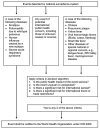Beyond traditional surveillance: applying syndromic surveillance to developing settings--opportunities and challenges
- PMID: 19607669
- PMCID: PMC2718884
- DOI: 10.1186/1471-2458-9-242
Beyond traditional surveillance: applying syndromic surveillance to developing settings--opportunities and challenges
Abstract
Background: All countries need effective disease surveillance systems for early detection of outbreaks. The revised International Health Regulations [IHR], which entered into force for all 194 World Health Organization member states in 2007, have expanded traditional infectious disease notification to include surveillance for public health events of potential international importance, even if the causative agent is not yet known. However, there are no clearly established guidelines for how countries should conduct this surveillance, which types of emerging disease syndromes should be reported, nor any means for enforcement.
Discussion: The commonly established concept of syndromic surveillance in developed regions encompasses the use of pre-diagnostic information in a near real time fashion for further investigation for public health action. Syndromic surveillance is widely used in North America and Europe, and is typically thought of as a highly complex, technology driven automated tool for early detection of outbreaks. Nonetheless, low technology applications of syndromic surveillance are being used worldwide to augment traditional surveillance.
Summary: In this paper, we review examples of these novel applications in the detection of vector-borne diseases, foodborne illness, and sexually transmitted infections. We hope to demonstrate that syndromic surveillance in its basic version is a feasible and effective tool for surveillance in developing countries and may facilitate compliance with the new IHR guidelines.
Figures
Similar articles
-
Redefining syndromic surveillance.J Epidemiol Glob Health. 2011 Dec;1(1):21-31. doi: 10.1016/j.jegh.2011.06.003. Epub 2011 Jul 28. J Epidemiol Glob Health. 2011. PMID: 23856373 Free PMC article. Review.
-
The remarkable adaptability of syndromic surveillance to meet public health needs.J Epidemiol Glob Health. 2013 Mar;3(1):41-7. doi: 10.1016/j.jegh.2012.12.005. Epub 2013 Jan 20. J Epidemiol Glob Health. 2013. PMID: 23856537 Free PMC article. Review.
-
The role of disease surveillance in achieving IHR compliance by 2012.Biosecur Bioterror. 2011 Dec;9(4):408-12. doi: 10.1089/bsp.2011.0053. Epub 2011 Nov 10. Biosecur Bioterror. 2011. PMID: 22074350
-
Meeting the International Health Regulations (2005) surveillance core capacity requirements at the subnational level in Europe: the added value of syndromic surveillance.BMC Public Health. 2015 Feb 7;15:107. doi: 10.1186/s12889-015-1421-2. BMC Public Health. 2015. PMID: 25879869 Free PMC article.
-
Implementing the new International Health Regulations in the Pacific--challenges and opportunities.Pac Health Dialog. 2005 Sep;12(2):135-43. Pac Health Dialog. 2005. PMID: 18181505
Cited by
-
Evaluation of outbreak detection performance using multi-stream syndromic surveillance for influenza-like illness in rural Hubei Province, China: a temporal simulation model based on healthcare-seeking behaviors.PLoS One. 2014 Nov 19;9(11):e112255. doi: 10.1371/journal.pone.0112255. eCollection 2014. PLoS One. 2014. PMID: 25409025 Free PMC article.
-
Sustaining surveillance: evaluating syndromic surveillance in the Pacific.Glob Public Health. 2012;7(7):682-94. doi: 10.1080/17441692.2012.699713. Epub 2012 Jul 20. Glob Public Health. 2012. PMID: 22817479 Free PMC article.
-
Valuing Health Surveillance as an Information System: Interdisciplinary Insights.Front Public Health. 2019 Jun 13;7:138. doi: 10.3389/fpubh.2019.00138. eCollection 2019. Front Public Health. 2019. PMID: 31263687 Free PMC article.
-
A real-time spatio-temporal syndromic surveillance system with application to small companion animals.Sci Rep. 2019 Nov 28;9(1):17738. doi: 10.1038/s41598-019-53352-6. Sci Rep. 2019. PMID: 31780686 Free PMC article.
-
Predictors of Neonatal Tetanus Mortality in Katsina State, Northwestern Nigeria.Health Serv Res Manag Epidemiol. 2017 Sep 6;4:2333392817723970. doi: 10.1177/2333392817723970. eCollection 2017 Jan-Dec. Health Serv Res Manag Epidemiol. 2017. PMID: 35146071 Free PMC article.
References
-
- Smolinksi MS, Hamburg MA, Lederberg J. Microbial threats to health: emergence, detection, and response. Washington, DC: National Academies Press; 2003. - PubMed
-
- New IHR 2005 58th World Health Assembly 2005. Revision of the International Health Regulations. http://www.who.int/csr/ihr/IHRWHA58_3-en.pdf [cited 6/17/08]
-
- Pavlin JA. Asia: Syndromic Surveillance in Asia – Opportunities and Challenges. International Society for Disease Surveillance. Global Outreach Committee Newsletter. http://www.syndromic.org/Gonewsletter_v1_2008.html [cited 6/20/08]


